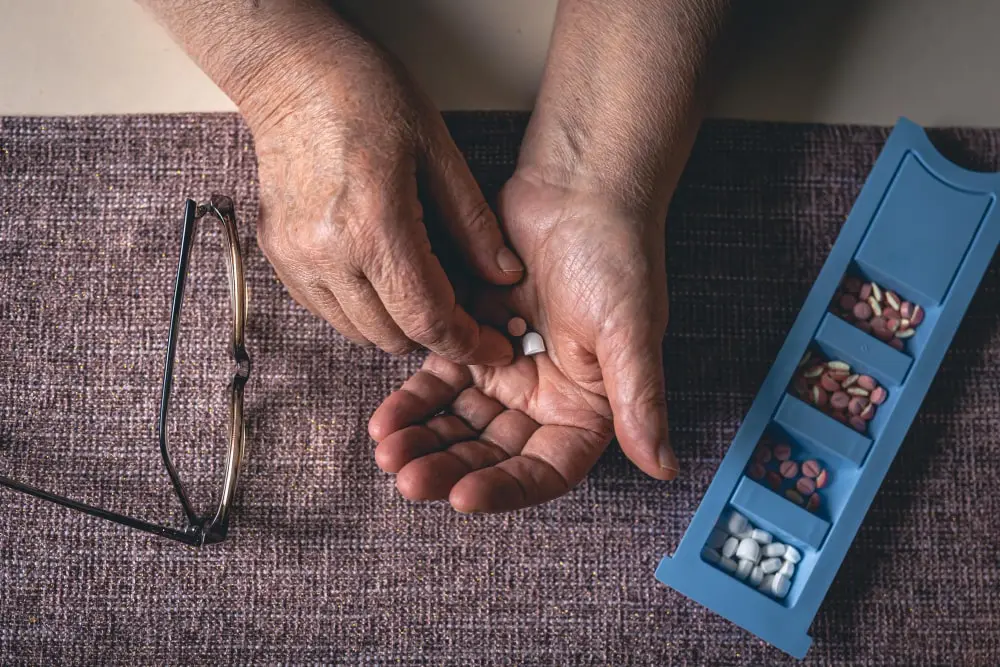If you’re taking Eliquis (apixaban) and dealing with pain, you’re not alone. About 17.9 million Eliquis prescriptions were filled in 2021. That number rose to roughly 19.4 million in 2022. This indicates its widespread use as a blood thinner in the U.S. Many adults over 50 take this medication. For some, this may raise an important question: which pain relievers are safe to use alongside it? The concern is real. Eliquis already increases your bleeding risk by design. Taking the wrong pain medication may increase the risk of bleeding. This can include internal bleeding. It may also cause cuts to bleed longer than usual. For seniors on fixed incomes, the stakes are even higher. You need affordable pain relief that won’t put you in the emergency room. The good news? Safe options do exist. This guide will walk you through which pain medications are safe with Eliquis and which ones to avoid. It also explains how to manage pain without breaking the bank.
Eliquis (Apixaban)
See highlights of prescribing information before buying Eliquis from Canada.
Understanding Eliquis (apixaban) and Bleeding Risks
Eliquis belongs to a class of blood thinners called Direct Oral Anticoagulants (DOACs). It works by blocking Factor Xa, a key protein in your blood’s clotting process. This mechanism prevents dangerous blood clots that can cause strokes or pulmonary embolisms.
Doctors prescribe Eliquis for several conditions:
- Atrial fibrillation
- Deep vein thrombosis
- Pulmonary embolism
- Prevention after hip or knee replacement surgery
Here’s the challenge: by preventing clots, Eliquis makes you bleed more easily and for longer periods. Even minor cuts take longer to stop bleeding. Internal bleeding becomes a serious concern, especially in your stomach, brain, or other vital organs. The CDC reports up to 900,000 U.S. cases of DVT/PE yearly. Many people who use Eliquis could also be looking for safe pain relief options.
Why Drug Interactions Matter on Anticoagulants
Drug interactions can be important when using anticoagulants like Eliquis. These drugs work in complex ways. Some medicines may change how they move through the body. Others may affect how they are processed in the liver or intestines.
Certain drugs may be involved with enzymes like CYP3A4. Some may also involve P-gp transport proteins. A few medicines are taken for infections or seizures. Others are used for pain or heart conditions. All of these may interact differently.
The effect can vary from person to person. That’s why drug combinations are often reviewed. Each case may need individual attention.
Navigating Eliquis and Over-the-Counter Pain Medication
Acetaminophen (Tylenol)
Acetaminophen (Tylenol) is your safest bet for pain relief while taking Eliquis. Unlike other pain relievers, it doesn’t affect your platelets or increase bleeding risk significantly.
Safe dosing guidelines:
- Follow the directions on the package or your doctor’s instructions carefully.
- Do not take more of the medication than recommended on the label or prescribed.
- Do not take more than one product containing acetaminophen at a time.
- If treating a child, use the child’s weight to find the right dose on the product label.
- Use the measuring device that comes with the medication to give the correct amount.
- If you are unsure how much to give a child, contact a doctor or pharmacist.
Important precautions:
- Tell your doctor if you are allergic to acetaminophen or any other drugs.
- Do not use acetaminophen if you consume three or more alcoholic drinks every day.
- Tell your doctor if you have or have ever had liver disease.
- Pregnant or breastfeeding women should consult their doctor before using acetaminophen.
- Do not give adult-strength acetaminophen to children under 12.
- Do not take two medicines containing acetaminophen at the same time.
Why it’s safer
Acetaminophen works in your brain to reduce pain signals. It doesn’t affect your stomach lining or interfere with platelet function like other pain relievers do.
Topical NSAIDs
Topical NSAIDs like diclofenac gel (Voltaren) may be safer options for localized pain. These medications have lower systemic absorption, meaning less gets into your bloodstream.
Benefits of Using Topical NSAIDs Like Diclofenac
- Applied directly to the skin over painful joints.
- Used to relieve arthritis pain in knees, ankles, feet, elbows, wrists, or hands.
- May offer pain relief with less drug entering the bloodstream (compared to oral NSAIDs).
Important Considerations When Using Diclofenac Topical
- Only apply to clean, dry, unbroken skin.
- Avoid getting it in your eyes, nose, or mouth.
- Do not cover the treated area with dressings or use heat unless directed.
- Stay out of sunlight or use protective clothing on treated areas.
- Wash hands after applying (unless treating hands).
- Do not use with other NSAIDs unless your doctor says it’s okay.
Always discuss topical NSAIDs with your doctor before starting. Even with lower absorption, some bleeding risk remains.
Non-NSAID Analgesics
For chronic pain conditions, doctors may consider:
- Certain antidepressants for neuropathic pain
- Anticonvulsants like gabapentin for nerve pain
- Muscle relaxants for specific conditions
This is because the FDA-approved label for Eliquis does not list these as known drug interactions.
Pain Medications to Avoid with Eliquis
Oral NSAIDs
Oral NSAIDs like ibuprofen or naproxen should be avoided while taking Eliquis. These drugs increase the risk of serious bleeding. Even short-term use can be risky.
Hidden sources
Many prescription pain combinations contain NSAIDs. Always check labels and ask your pharmacist about any new medications.
Aspirin
Aspirin also affects blood clotting. Taking it with Eliquis can further raise bleeding chances. The FDA warns against using both unless clearly needed. Always talk to your doctor before using these pain relievers with Eliquis. Never start or stop aspirin on your own while taking Eliquis. This decision requires medical supervision and regular monitoring.
Exploring Natural Pain Solutions When on Eliquis
Physical Therapy & Exercise
Physical therapy can provide lasting pain relief without medication risks. Here are some benefits:
- Faster recovery after injury or surgery.
- Prevention of further complications.
- Enhanced quality of life.
Many Medicare plans cover physical therapy. Ask your doctor for a referral if you’re dealing with chronic pain.
Acupuncture & Chiropractic Care
Alternative therapies may help certain types of pain. Some alternative therapies may include:
Bleeding considerations: Inform all practitioners that you’re taking Eliquis. Some procedures may need modification to reduce bleeding risk.
Heat, Cold, and Bracing
Simple home remedies can provide significant relief such as:
- Heat therapy for muscle stiffness.
- Cold therapy for acute injuries.
- Supportive braces for joint pain.
These methods have no drug interactions and can be used safely with Eliquis.
Tips to Minimize Bleeding Risk
Monitor for Bleeding Signs
It may be helpful to watch for unusual bruising, prolonged bleeding, or blood in urine or stool. Some people might also look out for sudden headaches or dizziness. These could be signs worth mentioning to a doctor.
Coordinate Your Care
Consider informing all healthcare providers about your Eliquis use. Carrying an updated medication list to appointments might help. Using the same pharmacy could reduce confusion. It may be wise to ask about interactions before starting new medicines.
Read Labels Carefully
Checking labels on over-the-counter medicines might help avoid ingredients like NSAIDs. Some products may contain hidden acetaminophen. Asking a pharmacist before taking any supplement or “natural” remedy could help prevent unwanted effects.
Regular Monitoring
Keeping doctor appointments might support safe medication use. If anything unusual happens, such as unexpected bleeding, it may be worth contacting a provider. Stopping Eliquis without medical advice might not be recommended. Some patients may need regular tests.
How to Save on Eliquis with DoctorSolve
Prescription costs can strain fixed incomes, but legitimate options exist for savings. DoctorSolve.com connects you with licensed Canadian pharmacies offering significant discounts on Eliquis.
How it works:
- Upload your prescription.
- We verify it with licensed Canadian pharmacies.
- You receive authentic medication at reduced costs.
- Medications are shipped directly to your door.
Eliquis and Pain Meds: What You Need to Know (FAQs)
What painkillers can I take while taking Eliquis?
Acetaminophen (Tylenol) is your safest first-line choice. Topical NSAIDs may be acceptable with doctor approval. Avoid oral NSAIDs and aspirin unless specifically prescribed.
What is the best pain reliever when on blood thinners?
For DOACs like Eliquis, acetaminophen is consistently the safest option. It doesn’t affect platelets or irritate your stomach lining like other pain relievers.
What sleep aid can you take with Eliquis?
Melatonin and diphenhydramine (Benadryl) are generally considered safe. Always consult your doctor before starting any sleep medication while on Eliquis.
Can I use CBD or other natural pain relievers?
CBD and other supplements can interact with Eliquis metabolism. Natural doesn’t mean safe. Always discuss any supplements with your doctor and pharmacist before use.
What should you do if you accidentally take ibuprofen with Eliquis?
Contact your doctor immediately. Don’t panic, but seek medical guidance. They may want to monitor you more closely or adjust your treatment plan temporarily.
Conclusion
Navigating pain management while on Eliquis is a crucial aspect of your overall health. As we’ve explored, understanding the interactions between Eliquis and pain medication is key to ensuring your safety and well-being. While Eliquis significantly reduces the risk of dangerous blood clots, it also increases your bleeding risk, making careful choices about pain relievers essential. Fortunately, safe and effective pain relief options are available.
Acetaminophen remains the safest choice due to its mechanism of action, which doesn’t interfere with platelet function or stomach lining. For localized pain, topical NSAIDs may be considered with your doctor’s approval, as they have lower systemic absorption. Remember to avoid oral NSAIDs and aspirin unless specifically directed by a healthcare professional, as these can significantly increase bleeding risk.
Beyond medication, natural approaches such as physical therapy, acupuncture, chiropractic care, and simple hot/cold therapies offer drug-free ways to manage discomfort. Always communicate your Eliquis use to all healthcare providers and regularly monitor for any signs of unusual bleeding. Making informed decisions about Eliquis and pain relief empowers you to manage discomfort effectively while staying safe. For many, the cost of Eliquis and pain medication can be a significant concern. To help ease this financial burden, consider that you can order Eliquis online through DoctorSolve.com, a licensed Canadian pharmacy partner, accessing the same authentic medication at a more affordable price. Prioritizing your health and safety by making informed choices, and exploring cost-effective solutions, ensures you can manage pain effectively while on Eliquis.
References
- Clincalc. (2022). Apixaban: Drug Usage Statistics, United States, 2013 – 2022
- National Library Of Medicine. (2013). Anticoagulation In Patients Aged ≥75 Years With Atrial Fibrillation: Role Of Novel Oral Anticoagulants
- Bms.Customerconnect.Com (2025). The #1 Prescribed Oral Blood Thinner
- Fda.Gov. (2025). Highlights Of Prescribing Information
- Cdc.Gov. (2025). Deep Vein Thrombosis And Pulmonary Embolism
- Drugs.Com. (2025). Drug Interactions Between Apixaban And Tylenol
- Harvard Health. (2019). Bad Mix: Blood Thinners And Nsaids
- Medlineplus.Com. (2023). Acetaminophen
- National Library Of Medicine. (2000). Oral Versus Topical Nsaids In Rheumatic Diseases: A Comparison
- Medlineplus.Com. (2021). Diclofenac Topical (Arthritis Pain)
- National Library Of Medicine. (2021). Characterization Of The Presence And Function Of Platelet Opioid Receptors
- National Library Of Medicine. (2021). Problematic Opioid Use Among Older Adults: Epidemiology, Adverse Outcomes And Treatment Considerations
- National Library Of Medicine. (2023). Anticoagulant Use In Older Persons At Risk For Falls: Therapeutic Dilemmas—A Clinical Review
- National Library Of Medicine. (2024). In Brief: Physical Therapy
- Medicare.Gov. (2025). Physical Therapy Services
- National Library Of Medicine. (2011). Acupuncture And Chiropractic Care For Chronic Pain In An Integrated Health Plan: A Mixed Methods Study
- Healthline. (2017). Treating Pain With Heat And Cold
- National Library Of Medicine. (2015). Braces And Orthoses For Treating Osteoarthritis Of The Knee
- Drugs.Com. (2025). Drug Interactions Between Eliquis And Melatonin
- Drugs.Com. (2025). Drug Interactions Between Apixaban And Benadryl
- National Library Of Medicine. (2021). Potential Drug Interactions Between Cannabinoids And Its Derivatives And Oral Anticoagulants
- National Library Of Medicine. (2005). Patterns Of Use And Public Perception Of Over-The-Counter Pain Relievers: Focus On Nonsteroidal Antiinflammatory Drugs
- Cdc.Gov. (2024). About Atrial Fibrillation







